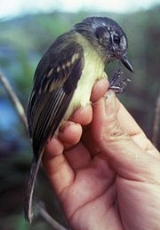
Slaty-capped Flycatcher
Encyclopedia
The Slaty-capped Flycatcher, Leptopogon superciliaris, is a small passerine
bird
in the tyrant flycatcher
family. It breeds from Costa Rica
through Colombia
and northern Venezuela
to northern Bolivia
, Ecuador
, and Peru
. It also occurs on Trinidad
.
This species is found in forests and woodland edges. The nest is a ball lined with fine plant fibres, with a side entrance. It is suspended by a tendril or root and built in a heavily shaded area, such as a rock cleft or under hanging vegetation at the top of a bank. The typical clutch is two white eggs. The chicks fledge about 20 days after hatching.
The adult Slaty-capped Flycatcher is 14 cm long and weighs 12.6g. The head has a dark grey crown, grey and white face, grey supercilium, and black crescentic ear patch. The upperparts are olive-green and the dusky wings have two yellowish wing bars. The throat is whitish and the breast is greenish yellow shading to yellow on the belly. The long heavy bill is black above and pink-based below. Sexes are similar, but young birds have a more olive crown, weaker face pattern, orange wing bars and paler underparts.
Slaty-capped Flycatcher are seen alone or in pairs, perched in the open or catching insect
s in flight or from foliage. They also frequently eat berries. They have a sharp switch-choo call.
Passerine
A passerine is a bird of the order Passeriformes, which includes more than half of all bird species. Sometimes known as perching birds or, less accurately, as songbirds, the passerines form one of the most diverse terrestrial vertebrate orders: with over 5,000 identified species, it has roughly...
bird
Bird
Birds are feathered, winged, bipedal, endothermic , egg-laying, vertebrate animals. Around 10,000 living species and 188 families makes them the most speciose class of tetrapod vertebrates. They inhabit ecosystems across the globe, from the Arctic to the Antarctic. Extant birds range in size from...
in the tyrant flycatcher
Tyrant flycatcher
The tyrant flycatchers are a family of passerine birds which occur throughout North and South America. They are considered the largest family of birds on Earth, with more than 400 species. They are the most diverse avian family in every country in the Americas, except for the United States and...
family. It breeds from Costa Rica
Costa Rica
Costa Rica , officially the Republic of Costa Rica is a multilingual, multiethnic and multicultural country in Central America, bordered by Nicaragua to the north, Panama to the southeast, the Pacific Ocean to the west and the Caribbean Sea to the east....
through Colombia
Colombia
Colombia, officially the Republic of Colombia , is a unitary constitutional republic comprising thirty-two departments. The country is located in northwestern South America, bordered to the east by Venezuela and Brazil; to the south by Ecuador and Peru; to the north by the Caribbean Sea; to the...
and northern Venezuela
Venezuela
Venezuela , officially called the Bolivarian Republic of Venezuela , is a tropical country on the northern coast of South America. It borders Colombia to the west, Guyana to the east, and Brazil to the south...
to northern Bolivia
Bolivia
Bolivia officially known as Plurinational State of Bolivia , is a landlocked country in central South America. It is the poorest country in South America...
, Ecuador
Ecuador
Ecuador , officially the Republic of Ecuador is a representative democratic republic in South America, bordered by Colombia on the north, Peru on the east and south, and by the Pacific Ocean to the west. It is one of only two countries in South America, along with Chile, that do not have a border...
, and Peru
Peru
Peru , officially the Republic of Peru , is a country in western South America. It is bordered on the north by Ecuador and Colombia, on the east by Brazil, on the southeast by Bolivia, on the south by Chile, and on the west by the Pacific Ocean....
. It also occurs on Trinidad
Trinidad
Trinidad is the larger and more populous of the two major islands and numerous landforms which make up the island nation of Trinidad and Tobago. It is the southernmost island in the Caribbean and lies just off the northeastern coast of Venezuela. With an area of it is also the fifth largest in...
.
This species is found in forests and woodland edges. The nest is a ball lined with fine plant fibres, with a side entrance. It is suspended by a tendril or root and built in a heavily shaded area, such as a rock cleft or under hanging vegetation at the top of a bank. The typical clutch is two white eggs. The chicks fledge about 20 days after hatching.
The adult Slaty-capped Flycatcher is 14 cm long and weighs 12.6g. The head has a dark grey crown, grey and white face, grey supercilium, and black crescentic ear patch. The upperparts are olive-green and the dusky wings have two yellowish wing bars. The throat is whitish and the breast is greenish yellow shading to yellow on the belly. The long heavy bill is black above and pink-based below. Sexes are similar, but young birds have a more olive crown, weaker face pattern, orange wing bars and paler underparts.
Slaty-capped Flycatcher are seen alone or in pairs, perched in the open or catching insect
Insect
Insects are a class of living creatures within the arthropods that have a chitinous exoskeleton, a three-part body , three pairs of jointed legs, compound eyes, and two antennae...
s in flight or from foliage. They also frequently eat berries. They have a sharp switch-choo call.

